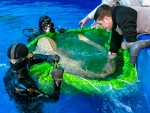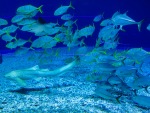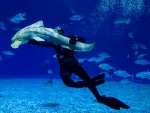A stir in the Ocean Abyss
Two zebra sharks (Stegostoma fasciatum), the Aquarium’s biggest fish, have become permanent residents of the “Ocean Abyss” tank, which is the largest one in the Primorsky Aquarium.
“The zebra sharks arrived to the Primorsky Aquarium from Japan last September. The fish have adapted themselves to the new environment and are entirely ready to be exhibited,” said Mikhail Streltsov, Head of the Tropical Marine Fish Department. “The Ocean Abyss is not a simple display of large fishes; here we aim to show particular areas of the World Ocean inhabited by the most fascinating fish species.”
Our zebra sharks are about five years old; they have reached sexual maturity and changed their colour pattern from juvenile black and white stripes to impressive dark-on-light spots. The female has grown to a length of 2 m 53 cm and a weight of 55 kg, and it is larger than the male that is 170 cm long and weighs about 30 kg.
At first, the zebra sharks learnt to approach to the divers beckoning them over and feed out of hands. Then the fish were taught to perform more complicated tasks, for example, to make a head stand on the diver’s hand. Training capacities of the Research Building for Adaptation are insufficient for the adult sharks, and they will be further trained in the largest tank of the Aquarium. The fish certainly need time to get used to their new home but the divers started working with them right on the moving day.
The newcomers caused quite a stir among the long-term inhabitants of the exhibit. Giant groupers were the first to meet the zebra sharks, as they had to make sure that the new settlers pose no threat to them and to claim the fish tank as theirs. Numerous shoals of smaller fishes persistently follow the sharks exploring the territory. “A fish is as curious as a man,” said Mikhail Streltsov. “And accompanying a large predator has its advantages – in the wild it protects from sudden attacks of other predators.”
The zebra shark is not an active hunter; its massive head and drop-like body make high-speed hunting impossible. Its diet consists mainly of mollusks and crustaceans.
General information
Zebra sharks are widely distributed in the warm seas of the Indian and Pacific Oceans. Their lifespan is 25-30 years.
This species is oviparous. Adult sharks have a leopard-like spotted pattern. But the species got the name due to its juvenile colouration with zebra-like stripes. This radical difference in body colour of “parents” and “children” serves to protect the latter: adult specimens do not attack white-striped young ones.
The zebra shark is often confused with the leopard shark. The zebra shark is distinguished by a ribbon-like caudal fin that reaches half its full body length.


